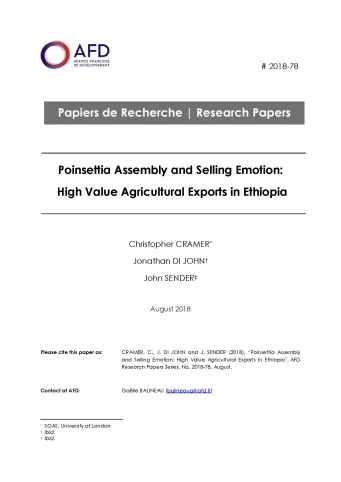Share the page
Poinsettia Assembly and Selling Emotion: High Value Agricultural Exports in Ethiopia
Published on

We examine how investment in high-value agriculture can help to address the balance of payments constraint on growth and the wage employment challenge in Ethiopia while accelerating structural change. The industrialization of freshness has significant implications for policy priorities.
Development cannot be sustainable without structural change, in Arthur Lewis’s sense of a shift of people out of low and into progressively higher productivity economic activities. This process has often been (mis)understood as a rural to urban shift, or as only a departure from agriculture and into those sectors classified as manufacturing or industrial. However, our research, which draws on fieldwork in Ethiopia, shows that simple sectoral classifications have become increasingly unfit for purpose. Besides the process of ‘servicification’, i.e. the greater share of final value of manufactured goods derived from service activities like logistics, marketing and branding, we argue that there is a parallel process of the ‘industrialization of freshness’. Structural change is taking place within agriculture and rural areas rather than away from them, but the implications for ‘industrial’ strategies are rarely discussed. Among the influences accelerating an industrialization of freshness are a globalized unbundling of production, technical change, and the increasing significance of phyto-sanitary, quality, and ‘ethical’ standards.
Our interviews with farm managers and owners, as well as airline managers and government officials, show that several agricultural enterprises are increasingly knowledge-intense, organizationally and technically sophisticated and by a reasonable definition ‘industrial’. Moreover, we find that horticulture exports embody another dimension of complex, cross-sectoral economic activity through their reliance on extremely sophisticated logistics and transport. The horticulture export sector has created far greater demands and pressures for the development of up-to-date transport and logistics in Ethiopia than, for example, the textile and leather sectors.
We then identify, within the context of the Upper Awash Valley in Ethiopia, some of the apparently technical but, above all, socio- political constraints limiting the potential for high value agriculture to contribute to growth and structural change.
Our method and findings are very different from the literature on ‘complexity’ and ‘product space’ and they query pessimistic conclusions about ‘premature deindustrialization’. And our findings suggest the need to rethink how industrial strategies can promote structural change: much more support should be directed to high value agricultural production and less focus on assembling garments or trainers in subsidized industrial parks.
Useful Information
-
Authors
-
Christopher CRAMER, Jonathan DI JOHN, John SENDER
-
Coordinators
-
Gaëlle BALINEAU
-
Edition
-
78
-
Number of pages
-
52
-
ISSN
-
2492 - 2846
-
Collection
-
Research Papers
